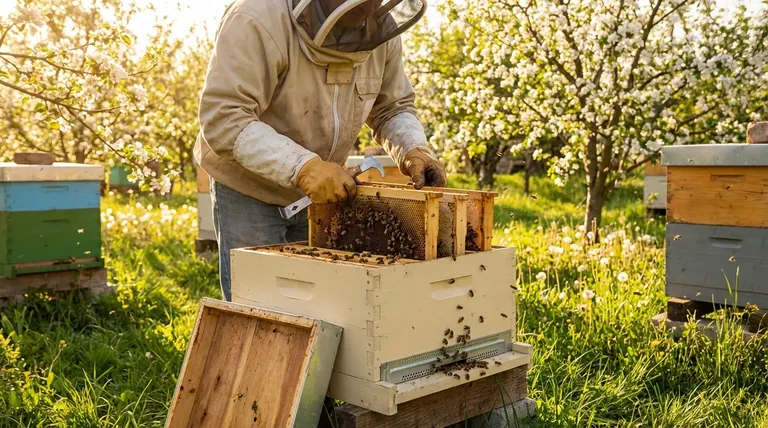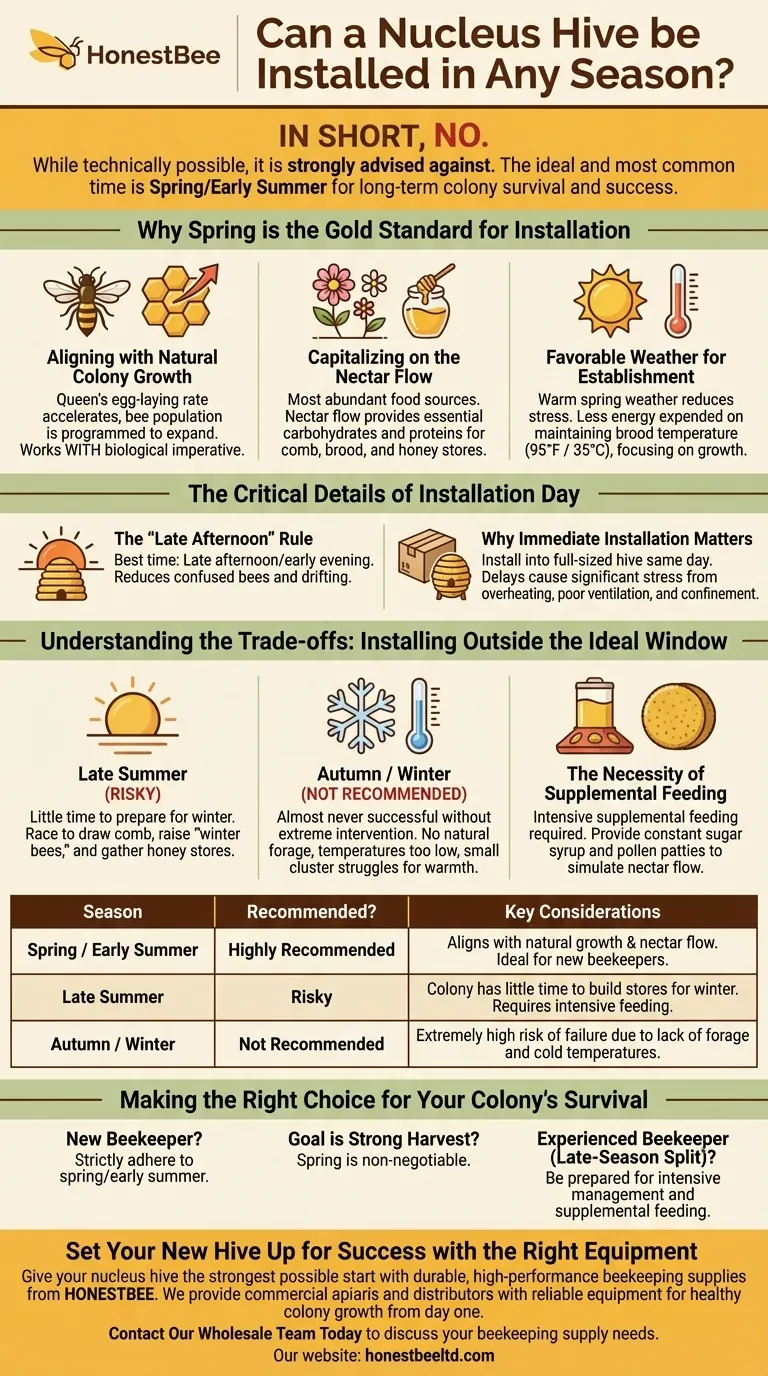In short, no. While it is technically possible to install a nucleus hive in seasons other than spring, it is strongly advised against. The ideal and most common time for installation is during the spring or early summer, as this timing is critical for the colony's long-term survival and success.
Success in beekeeping is about aligning your actions with the colony's natural cycle. Installing a nucleus hive is not just a logistical task; it is the act of giving a young colony its best chance to thrive by synchronizing its start with the peak availability of natural resources.

Why Spring is the Gold Standard for Installation
Timing your installation is about giving the new colony the strongest possible foundation. Spring provides a set of ideal conditions that are difficult or impossible to replicate at other times of the year.
Aligning with Natural Colony Growth
A nucleus hive, or "nuc," is a small, starter colony. In spring, a queen's egg-laying rate naturally accelerates, and the bee population is programmed to expand. Installing a nuc during this period works with this biological imperative, not against it.
Capitalizing on the Nectar Flow
Spring and early summer offer the most abundant food sources. This "nectar flow" from blooming flowers provides the essential carbohydrates and proteins (pollen) the colony needs to draw out comb, raise new brood, and build up honey stores.
Favorable Weather for Establishment
Warm spring weather reduces stress on the colony. Bees don't need to expend as much energy maintaining the critical 95°F (35°C) temperature required for brood development, allowing them to focus resources on growth and foraging.
The Critical Details of Installation Day
Beyond the season, the timing on the actual day of installation is also crucial for minimizing stress and ensuring a smooth transition.
The "Late Afternoon" Rule
The best time of day to install your nuc is in the late afternoon or early evening. By this time, most of the forager bees have returned home for the night. This simple step dramatically reduces the number of bees that become confused and "drift" back to the nuc's original location.
Why Immediate Installation Matters
A nucleus hive is a temporary transport box, not a permanent home. It is crucial to install the bees into their full-sized hive the same day you receive them. Delays cause significant stress from overheating, poor ventilation, and confinement, which can weaken the colony before it even gets started.
Understanding the Trade-offs: Installing Outside the Ideal Window
Attempting to establish a hive outside of the prime spring window introduces significant challenges that often lead to colony failure, especially for new beekeepers.
The Challenge of a Late Summer Installation
Installing a nuc in late summer gives the bees very little time to prepare for winter. They face a race against the clock to draw comb, raise enough new "winter bees," and gather sufficient honey stores before the nectar flow ends and cold weather arrives.
The High Risk of an Autumn or Winter Installation
Installing a colony in autumn or winter is almost never successful without extreme intervention. There is no natural forage, temperatures are too low for the queen to lay effectively, and the small cluster of bees will struggle to stay warm. The colony will likely perish.
The Necessity of Supplemental Feeding
If you are forced into a late-season installation, you must be prepared to engage in an intensive supplemental feeding program. You will need to provide a constant supply of sugar syrup and pollen patties to simulate a nectar flow and give the bees the resources they need to survive.
Making the Right Choice for Your Colony's Survival
Your goal is not just to install bees but to foster a healthy, self-sufficient colony. The timing of that installation is your first and most important decision in achieving that goal.
- If you are a new beekeeper: Strictly adhere to a spring or early summer installation. This gives you the highest probability of success and the best learning experience.
- If your primary goal is a strong first-year harvest: A spring installation is non-negotiable. This provides the longest runway for the colony to build up its population and store surplus honey.
- If you are an experienced beekeeper attempting a late-season split: Be prepared for intensive management, including consistent supplemental feeding and close monitoring, to ensure the colony has a chance to survive winter.
Choosing the right season gives your new colony the critical head start it needs to become a thriving, productive hive.
Summary Table:
| Season | Recommended? | Key Considerations |
|---|---|---|
| Spring / Early Summer | Highly Recommended | Aligns with natural growth & nectar flow. Ideal for new beekeepers. |
| Late Summer | Risky | Colony has little time to build stores for winter. Requires intensive feeding. |
| Autumn / Winter | Not Recommended | Extremely high risk of failure due to lack of forage and cold temperatures. |
Set Your New Hive Up for Success with the Right Equipment
Give your nucleus hive the strongest possible start with durable, high-performance beekeeping supplies from HONESTBEE. We provide commercial apiaries and distributors with the reliable equipment needed to support healthy colony growth from day one.
Contact Our Wholesale Team Today to discuss your beekeeping supply needs.
Visual Guide

Related Products
- HONESTBEE Professional Multi-Functional Hive Tool with Ergonomic Wood Handle
- HONESTBEE Professional Long Handled Hive Tool with Precision Cutting Blade
- HONESTBEE Advanced Ergonomic Stainless Steel Hive Tool for Beekeeping
- Multi-Function Plier-Style Frame Grip Hive Tool
- Long Langstroth Style Horizontal Top Bar Hive for Wholesale
People Also Ask
- What is the hole in a hive tool for? A Multi-Tool for Apiary Repairs and Maintenance
- Why is it recommended to have multiple hive tools on hand? Essential Tips for Efficient Beekeeping
- What should beginners consider when purchasing beekeeping equipment? A Guide to Essential Starter Gear
- What are the features of a J-hook hive tool? Effortlessly Lift Frames with Superior Leverage
- What is a multifunction scraper hive tool? The All-in-One Solution for Efficient Beekeeping



















